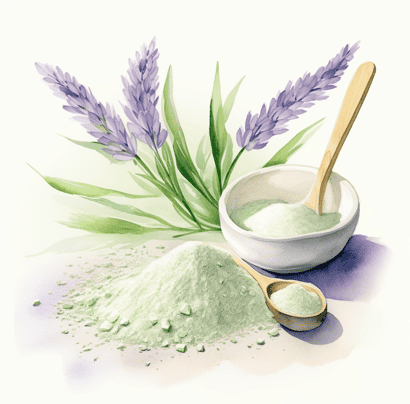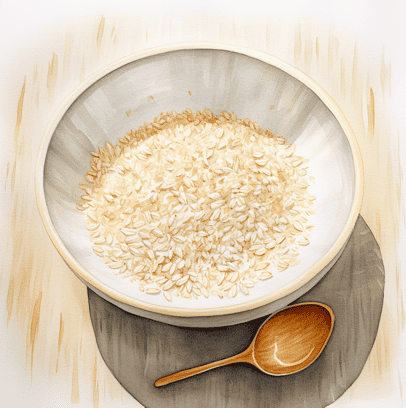
Don’t want to read the whole post?
Oat flour and oat fibre each offer unique benefits for a health-conscious woman’s diet. While oat flour, made from the whole oat kernel, provides essential nutrients and is a great option for gluten-free recipes, oat fibre, derived from the husk of the oat grain, is rich in pure insoluble fibre, aiding digestion and potentially supporting weight management.
ABOUT ME
Be beauty. Be plant-based!
As a former Registered Nurse and avid plant-muncher, I’m in love with how simple plant-based foods make it easy to be beautiful.

You’ll also love:
Quinoa Flakes vs Oats: Which Boosts Your Beauty More?
Welcome to a world where your health and beauty goals meet simplicity and nourishment. If you’ve ever wondered about the difference between oat flour vs oat fibre, you’re in the right place. These two power-packed ingredients play unique roles in a plant-based diet, offering a multitude of benefits for your busy lifestyle.
Understanding Oat Flour
What is Oat Flour?
Let’s start with whole grain oat flour. Oat flour is a fine powder made from ground oats.
It’s a fantastic staple in the world of oat products. Originating from the oat kernel, this versatile flour is more than just a baking ingredient.
It’s a gateway to a gluten-free diet, opening up a world of delicious and nutritious possibilities. When you’re browsing through oat flour recipes, you’re not just looking at a list of sweet treats and bread; you’re exploring a journey towards better health.

But what about those times when oat flour isn’t quite what you need? No worries! There are plenty of oat flour substitutes out there. From almond flour to coconut flour, these substitutes cater to various dietary needs without compromising on taste or nutrition.
Understanding Oat Fibre
Let’s delve into the world of oat fibre, a unique and beneficial component in a health-conscious diet.
What is Oat Fibre?
Oat fibre is derived from the hull of the oat grain. Unlike oat flour, it contains mostly pure insoluble fibre. This makes it an exceptional choice for adding extra fibre to your diet without significantly increasing calories or carbohydrates.

How to Use Oat Fibre
Oat fibre is a great ingredient for boosting the fibre content in baked goods, smoothies, and other recipes. However, due to its different textures compared to oat flour, it’s not suitable as a direct substitute in recipes that rely on the gluten or binding properties of flour. Oat fibre can be used to partially replace flour or other ingredients in recipes for an easy way to increase your fibre intake.
Nutritional Differences
Now, let’s delve into the heart of our discussion: the comparison between oat flour and oat fibre. Oat flour is a source of carbohydrates, protein, and various vitamins and minerals, making it an excellent component of a balanced diet.
On the other hand, oat fibre is specifically extracted from the non-digestible oat hull or the hull of the oat grain. This makes oat fibre an almost pure source of dietary fibre, with minimal calories and carbohydrates.
The fibre content in oat fibre is particularly noteworthy. If you’re looking to ensure you’re getting enough fibre in your diet, oat fibre can be a simple and effective addition. It doesn’t just aid in digestion; it also plays a role in maintaining heart health and regulating blood sugar levels.
Does oat flour have as much fibre as oatmeal?
Oat flour and oatmeal have similar grams of fibre per serving, but oatmeal may have a slight edge. While both are great ingredients for boosting fibre intake, oatmeal retains more of its natural fibre due to less processing. Oat flour, with its flour-like consistency, is a more versatile baking ingredient. It’s an easy way to add fibre to various dishes while maintaining a texture similar to traditional flour.
Can oat fibre be substituted for oat flour?
Oat fibre can’t directly substitute for oat flour because of their different properties. Oat fibre is a pure insoluble fibre with a flour-like consistency, while oat flour is a fine powder made from ground oats.
For best results in baking and cooking, use oat flour for its texture and rising properties. Oat fibre, being mostly fibre, doesn’t provide the same results but can be used as an additive for an easy way to increase the grams of fibre in recipes.
Making the Right Choice for Your Diet
Deciding between oat flour vs oat fibre depends largely on your personal health goals and dietary preferences.
If you’re aiming for a gluten-free diet or seeking a versatile baking ingredient, whole grain oat flour is your go-to. It provides the benefits of whole grains while being a great base for a variety of oat flour recipes.

For those on a keto diet or a low carb diet, oat fibre stands out as the better option. Its high fibre content and low carbohydrate profile make it an excellent choice for adding extra fibre to your meals without increasing your carb intake. It’s also a boon for anyone needing to boost their fibre intake for digestive health.
Incorporating these products into your plant-based diet doesn’t have to be complicated. Mix oat flour in your pancakes or use oat fibre as a thickener for soups and stews. Remember, even regular oats and whole grain oats can be part of this mix, offering variety and nutrition in your daily meals.Substituting Oat Flour for Oat Fibre (and Vice Versa)
Substituting Oat Flour for Oat Fibre (and Vice Versa)
Swapping oat flour and oat fibre in recipes can be tricky due to their distinct properties, but it’s not impossible. Here’s how to do it effectively:
Using Oat Fibre in Place of Oat Flour
Understand the Texture: Remember, oat fibre is a pure insoluble fibre with a very different texture compared to oat flour. It doesn’t have the same binding properties.
For Best Results: Use oat fibre to replace up to 1/3 of the oat flour in recipes. This maintains the structure of the baked goods while boosting the fibre content.
Adjust Liquids: Since oat fibre absorbs more liquid, you might need to increase the amount of liquid in your recipe to prevent dryness.

Using Oat Flour Instead of Oat Fibre
Nutritional Consideration: Oat flour is not just fibre; it contains carbohydrates and protein, affecting the nutritional profile of your dish.
Texture and Taste: As oat flour has a flour-like consistency and a mild taste, it can be used in a 1:1 ratio for oat fibre. However, it will decrease the overall fibre content of the recipe.
Keto-Friendly Options: If you’re following a keto diet, be mindful that substituting oat fibre with oat flour will add carbs to your recipe.
In both cases, remember that while these substitutions can work, they might slightly alter the final product’s texture and nutritional value. It’s always an easy way to experiment and adjust quantities to suit your taste and dietary needs.
Exploring Oat Bran and Other Products
Moving beyond oat flour, let’s explore oat bran. This nutrient-rich layer sits just under the in-edible hull of the oat grain, offering a concentrated source of fibre and other nutrients. Oat bran is a standout in the world of oat products, not just for its nutritional punch, but also for its versatility in cooking and baking. It’s a secret weapon for boosting fibre content in meals, making it a perfect addition to your plant-based diet.
But the oat family doesn’t end here. There’s a whole range of types of oats to consider, from the sturdy steel-cut oats to the quick and convenient instant oats. Each type, including rolled oats, regular oats, and whole oats, brings its unique texture and cooking time to the table. These variations cater to different culinary needs, whether you’re looking for a hearty breakfast or a quick snack. Understanding these types of oats can enrich your cooking experience, offering new ways to enjoy this versatile grain in your daily diet.
Conclusion
As we wrap up our exploration of oat flour vs oat fibre, remember that both these oat products have unique roles to play in your journey towards health and beauty. Whether you choose whole grain oat flour for its wholesome goodness in baking or oat fibre for that essential fibre intake boost, you’re making a choice that supports your well-being.
FAQ: Oat Flour vs Oat Fibre
Is oat fibre better than psyllium husk?
Oat fibre and psyllium husk powder serve different purposes due to their different textures and types of fibre. While both are great ingredients for health benefits like improving digestion, they work differently. Psyllium husk is more gelatinous and can aid in weight loss and bowel regularity. Oat fibre, made from the husk of the oats, is primarily pure insoluble fibre, which helps with digestive health. The choice depends on your specific health needs.
What are the cons of oat fibre?
One of the cons of oat fibre is that it’s mostly pure insoluble fibre, meaning it doesn’t absorb water or swell like other fibres. This can be less effective for those seeking a fibre that aids in feeling full or helps with bowel regularity. Also, due to its different textures, oat fibre might not blend as smoothly in some recipes compared to finer fibres like psyllium husk powder.
Can I replace psyllium husk with oat fibre?
While you can replace psyllium husk with oat fibre in some recipes, they have different textures and effects. Psyllium husk swells and creates a gel-like substance, which is beneficial for gluten-free baking and as a binding agent. Oat fibre, being a pure insoluble fibre with a flour-like consistency, doesn’t have this gelling property. For certain recipes, especially those requiring a binding agent, psyllium husk might be more suitable. However, for adding fibre content without changing the texture significantly, oat fibre is a good choice.